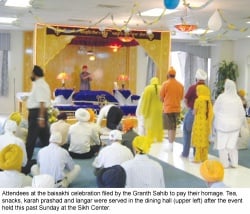Paath
| Part of a series on Sikh Practices |
| Sikhism |
| Sanskar |
| Sikh rites |
| Personal 5 Banis . Five ks |
Paath is the recitation of Gurbani. It may be done individually or in a group; it can be the recitation of one’s Banis or any part of the Siri Guru Granth Sahib, alone or with others listening or reciting along. The person reciting Gurbani should pronounce every syllable correctly so that the Naad, the sound current may be produced and affect the consciousness of the one reciting and the one listening.
Gurbani may be recited in the Sadh Sangat at any time, whether or not one is in the presence of Siri Guru Granth Sahib. A beautiful form of recitation in a group is to divide into groups of men and women with each reciting an alternate sutra. (A sutra is a complete line of poetry.) In the Gurmukhi each sutra is separated by two vertical lines (//). Gurbani should be recited rhythmically and meditatively.
PAATH or PATH, from the Sanskrit patha which means reading or recitation, is, in the religious context, reading or recitation of the holy texts. In Sikhism, it implies daily repetition of scriptural texts from the Guru Granth Sahib]. Reading of certain banis is part of a Sikh’s nitnem or daily religious regimen. Path of these prescribed texts is performed from a handy collection, called gutka (missal or breviary) or from memory. Three of the banis, Guru Nanak’s Japji and Guru Gobind Singh’s Jaap Sahib and Savaiye — constitute the Sikhs mandatory morning path or devotions, and two — Rehras and Kirtan Sohila — evening path. Individuals add certain other texts as well such as Shabad Hajare, Anand Sahib and Sukhmani.
The path is also performed individually and more particularly in sangat from the Guru Granth Sahib itself. The Holy Volume is ceremonially installed under coverlets on a decorated seat resting on a raised platform, with a canopy above, and is opened by the pathi or reader who sits reverentially behind. Usually, another man stands in attendance, waving the flywhisk over the Holy Book. The pathi should have bathed and be dressed in clean clothes. Besides the reading of one single hymn to obtain vak or hukamnama (lesson or command for the day) or of some passages, three forms of complete path of the Guru Granth Sahib are current: akhand Path (unbroken recitation completed in forty-eight hours), saptahik (completed in a week) and sadharan or sahij (taken in slow parts with no time-limit for completion). A rarest variety is ati akhand path, hardly ever practised, in which a single participant reads within the prescribed 48 hours the entire text.
Another variety is the sampat path. No time-limit is specified for it. Different schools and different groups or pathis have their own schedules. But the commonest factor in this variety of path is that a whole shabad or a portion of it from the holy text will be set apart for repetition after every full stanza or apportioned section of it has been recited. Time-limit will thus be variable, depending upon the length of the verse or verses chosen for repetition. The hymn or portions of it chosen for repeated recitation will be governed by the occasion or purpose of the path. At certain places even the Mul Mantra is repeated with the chosen line or lines. The relay of pathis (readers) in this instance will naturally be larger than in the case of a normal akhand path.
BIBLIOGRAPHY
Cole, W. Owen and Sambhi, P.S., The Sikhs: Their Religious Beliefs and Practices. Delhi, 1978 T. S.
Above adapted from article By Taran Singh
| Gurus: | Nanak Dev | Guru Angad | Amar Das | Ram Das | Guru Arjan | Har Gobind | Har Rai | Har Krishan | Tegh Bahadur | Gobind Singh | Guru Granth Sahib | Sikh Bhagats |
| Philosophy: | Sikh Beliefs | Simran | Sewa | Beliefs and Principles | Underlying Values | Prohibitions | Technique and Methods | Other observations | Technique and Methods |
| Practices: | Ardas | Amrit Sanskar | Chardi Kala | Dasvandh | Five Ks | Kirat Karni | Kirtan | Langar | Naam Japna | Simran | Three Pillars | Vand Chakna | Five Evils | Five Virtues |
| Scripture: | Guru Granth Sahib | Sikh Scripture | Dasam Granth | Ek Onkar | Waheguru | Bani | Mool Mantar | Japji Sahib | Jaap Sahib | Chaupai | Anand Sahib | Tav-Prasad Savaiye | Rehras | Sukhmani |
| More: | History | Gurdwaras | Harmandir Sahib | Khalsa | Khanda | Names | Places | News | Satguru | Sikhs | Bhagat Farid | Bhagat Kabir | Websites | Biographical | Terms |


